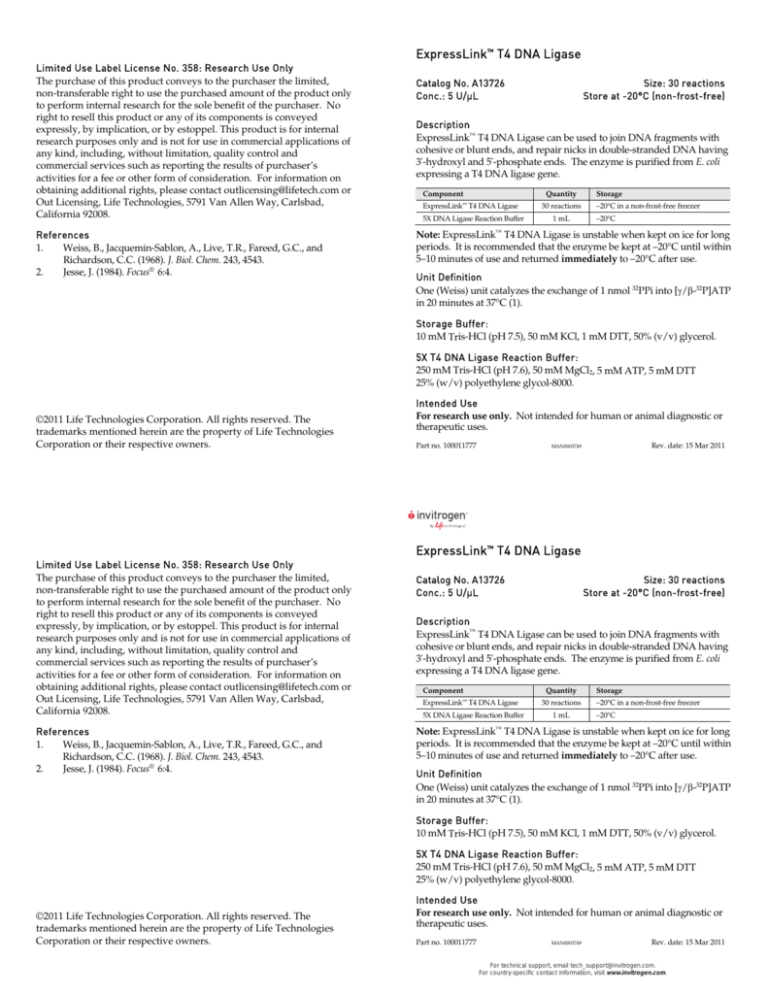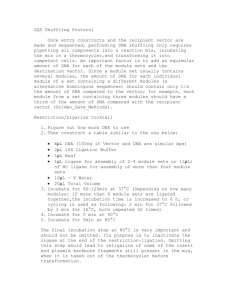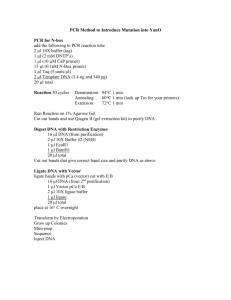
ExpressLink™ T4 DNA Ligase
Limited Use Label License No. 358: Research Use Only
The purchase of this product conveys to the purchaser the limited,
non-transferable right to use the purchased amount of the product only
to perform internal research for the sole benefit of the purchaser. No
right to resell this product or any of its components is conveyed
expressly, by implication, or by estoppel. This product is for internal
research purposes only and is not for use in commercial applications of
any kind, including, without limitation, quality control and
commercial services such as reporting the results of purchaser’s
activities for a fee or other form of consideration. For information on
obtaining additional rights, please contact outlicensing@lifetech.com or
Out Licensing, Life Technologies, 5791 Van Allen Way, Carlsbad,
California 92008.
References
1.
Weiss, B., Jacquemin-Sablon, A., Live, T.R., Fareed, G.C., and
Richardson, C.C. (1968). J. Biol. Chem. 243, 4543.
2.
Jesse, J. (1984). Focus® 6:4.
Catalog No. A13726
Conc.: 5 U/µL
Size: 30 reactions
Store at -20°C (non-frost-free)
Description
ExpressLink™ T4 DNA Ligase can be used to join DNA fragments with
cohesive or blunt ends, and repair nicks in double-stranded DNA having
3'-hydroxyl and 5'-phosphate ends. The enzyme is purified from E. coli
expressing a T4 DNA ligase gene.
Component
Quantity
ExpressLink™ T4 DNA Ligase
5X DNA Ligase Reaction Buffer
30 reactions
1 mL
Storage
–20°C in a non-frost-free freezer
–20°C
Note: ExpressLink™ T4 DNA Ligase is unstable when kept on ice for long
periods. It is recommended that the enzyme be kept at –20°C until within
5–10 minutes of use and returned immediately to –20°C after use.
Unit Definition
One (Weiss) unit catalyzes the exchange of 1 nmol 32PPi into [/-32P]ATP
in 20 minutes at 37°C (1).
Storage Buffer:
10 mM Tris-HCl (pH 7.5), 50 mM KCl, 1 mM DTT, 50% (v/v) glycerol.
5X T4 DNA Ligase Reaction Buffer:
250 mM Tris-HCl (pH 7.6), 50 mM MgCl2, 5 mM ATP, 5 mM DTT
25% (w/v) polyethylene glycol-8000.
©2011 Life Technologies Corporation. All rights reserved. The
trademarks mentioned herein are the property of Life Technologies
Corporation or their respective owners.
Intended Use
For research use only. Not intended for human or animal diagnostic or
therapeutic uses.
Part no. 100011777
Rev. date: 15 Mar 2011
MAN0003749
ExpressLink™ T4 DNA Ligase
Limited Use Label License No. 358: Research Use Only
The purchase of this product conveys to the purchaser the limited,
non-transferable right to use the purchased amount of the product only
to perform internal research for the sole benefit of the purchaser. No
right to resell this product or any of its components is conveyed
expressly, by implication, or by estoppel. This product is for internal
research purposes only and is not for use in commercial applications of
any kind, including, without limitation, quality control and
commercial services such as reporting the results of purchaser’s
activities for a fee or other form of consideration. For information on
obtaining additional rights, please contact outlicensing@lifetech.com or
Out Licensing, Life Technologies, 5791 Van Allen Way, Carlsbad,
California 92008.
References
1.
Weiss, B., Jacquemin-Sablon, A., Live, T.R., Fareed, G.C., and
Richardson, C.C. (1968). J. Biol. Chem. 243, 4543.
2.
Jesse, J. (1984). Focus® 6:4.
Catalog No. A13726
Conc.: 5 U/µL
Size: 30 reactions
Store at -20°C (non-frost-free)
Description
ExpressLink™ T4 DNA Ligase can be used to join DNA fragments with
cohesive or blunt ends, and repair nicks in double-stranded DNA having
3'-hydroxyl and 5'-phosphate ends. The enzyme is purified from E. coli
expressing a T4 DNA ligase gene.
Component
Quantity
ExpressLink™ T4 DNA Ligase
5X DNA Ligase Reaction Buffer
30 reactions
1 mL
Storage
–20°C in a non-frost-free freezer
–20°C
Note: ExpressLink™ T4 DNA Ligase is unstable when kept on ice for long
periods. It is recommended that the enzyme be kept at –20°C until within
5–10 minutes of use and returned immediately to –20°C after use.
Unit Definition
One (Weiss) unit catalyzes the exchange of 1 nmol 32PPi into [/-32P]ATP
in 20 minutes at 37°C (1).
Storage Buffer:
10 mM Tris-HCl (pH 7.5), 50 mM KCl, 1 mM DTT, 50% (v/v) glycerol.
5X T4 DNA Ligase Reaction Buffer:
250 mM Tris-HCl (pH 7.6), 50 mM MgCl2, 5 mM ATP, 5 mM DTT
25% (w/v) polyethylene glycol-8000.
©2011 Life Technologies Corporation. All rights reserved. The
trademarks mentioned herein are the property of Life Technologies
Corporation or their respective owners.
Intended Use
For research use only. Not intended for human or animal diagnostic or
therapeutic uses.
Part no. 100011777
MAN0003749
Rev. date: 15 Mar 2011
For technical support, email tech_support@invitrogen.com.
For country-specific contact information, visit www.invitrogen.com.
Rapid Ligation Protocol
Procedure
The following protocol is for rapid (5-minute) ligation of cohesive or
blunt ended DNA fragments.
1.
Reagent
5X Ligase Reaction Buffer
Vector DNA
Insert DNA
ExpressLink™ T4 DNA Ligase (units)
Autoclaved distilled water
General Information
A molar ratio of 3:1 insert:vector is recommended for the rapid ligation
of DNA inserts to vectors to produce circular recombinant molecules.
To calculate the amount of insert for a 3:1 ratio of vector to insert, use
the formula:
x ng of insert = 3 × insert size (in bp) × amount of vector (in ng)
vector size (in bp)
Thus, the calculation for a 3:1 molar ratio of a 830 bp insert to 100 ng of
a 5300 bp vector is:
3 × 830 bp (insert) × 100 ng (vector) = 47 ng (insert)
5300 bp (vector)
Subsequent to restriction endonuclease digestion, purify the insert
DNA from agarose using the PureLink® Quick Gel Extraction Kit
(Cat. no. K2100-12). Following restriction endonuclease digestion,
dephosphorylate the vector DNA. Dephosphorylated vector can be
used without purification if Calf Intestinal Alkaline Phosphatase
(CIAP) is heat-inactivated prior to ligation.
Add the following reagents to an autoclaved, 1.5-mL
microcentrifuge tube:
2.
Amount
4 μL
3–30 fmol
9–90 fmol
5 units (in 1 μL)
to 20 μL
Mix gently. Centrifuge briefly to bring the contents to the bottom of
the tube.
3.
Incubate at room temperature for 5 minutes.
4.
Use 2 μL of the ligation reaction to transform 100 μL of MAX
Efficiency® Competent cells.
Note: For optimal transformation, dilute the ligation reaction ≥ 5-fold, to
at least 100 μL, prior to adding to competent cells (2).
Before Starting
Thaw the 5X DNA Ligase Reaction Buffer at room temperature and
vortex vigorously to dissolve any precipitated material before use.
Rapid Ligation Protocol
Procedure
The following protocol is for rapid (5-minute) ligation of cohesive or
blunt ended DNA fragments.
1.
Reagent
5X Ligase Reaction Buffer
Vector DNA
Insert DNA
ExpressLink™ T4 DNA Ligase (units)
Autoclaved distilled water
General Information
A molar ratio of 3:1 insert:vector is recommended for the rapid ligation
of DNA inserts to vectors to produce circular recombinant molecules.
To calculate the amount of insert for a 3:1 ratio of vector to insert, use
the formula:
x ng of insert = 3 × insert size (in bp) × amount of vector (in ng)
vector size (in bp)
Thus, the calculation for a 3:1 molar ratio of a 830 bp insert to 100 ng of
a 5300 bp vector is:
3 × 830 bp (insert) × 100 ng (vector) = 47 ng (insert)
5300 bp (vector)
Subsequent to restriction endonuclease digestion, purify the insert
DNA from agarose using the PureLink® Quick Gel Extraction Kit
(Cat. no. K2100-12). Following restriction endonuclease digestion,
dephosphorylate the vector DNA. Dephosphorylated vector can be
used without purification if Calf Intestinal Alkaline Phosphatase
(CIAP) is heat-inactivated prior to ligation.
Before Starting
Thaw the 5X DNA Ligase Reaction Buffer at room temperature and
vortex vigorously to dissolve any precipitated material before use.
Add the following reagents to an autoclaved, 1.5-mL
microcentrifuge tube:
2.
Amount
4 μL
3–30 fmol
9–90 fmol
5 units (in 1 μL)
to 20 μL
Mix gently. Centrifuge briefly to bring the contents to the bottom of
the tube.
3.
Incubate at room temperature for 5 minutes.
4.
Use 2 μL of the ligation reaction to transform 100 μL of MAX
Efficiency® Competent cells.
Note: For optimal transformation, dilute the ligation reaction ≥ 5-fold, to
at least 100 μL, prior to adding to competent cells (2).
Rapid Ligation Protocol
Procedure
The following protocol is for rapid (5-minute) ligation of cohesive or
blunt ended DNA fragments.
1.
Reagent
5X Ligase Reaction Buffer
Vector DNA
Insert DNA
ExpressLink™ T4 DNA Ligase (units)
Autoclaved distilled water
General Information
A molar ratio of 3:1 insert:vector is recommended for the rapid ligation
of DNA inserts to vectors to produce circular recombinant molecules.
To calculate the amount of insert for a 3:1 ratio of vector to insert, use
the formula:
x ng of insert = 3 × insert size (in bp) × amount of vector (in ng)
vector size (in bp)
Thus, the calculation for a 3:1 molar ratio of a 830 bp insert to 100 ng of
a 5300 bp vector is:
3 × 830 bp (insert) × 100 ng (vector) = 47 ng (insert)
5300 bp (vector)
Subsequent to restriction endonuclease digestion, purify the insert
DNA from agarose using the PureLink® Quick Gel Extraction Kit
(Cat. no. K2100-12). Following restriction endonuclease digestion,
dephosphorylate the vector DNA. Dephosphorylated vector can be
used without purification if Calf Intestinal Alkaline Phosphatase
(CIAP) is heat-inactivated prior to ligation.
Add the following reagents to an autoclaved, 1.5-mL
microcentrifuge tube:
2.
Amount
4 μL
3–30 fmol
9–90 fmol
5 units (in 1 μL)
to 20 μL
Mix gently. Centrifuge briefly to bring the contents to the bottom of
the tube.
3.
Incubate at room temperature for 5 minutes.
4.
Use 2 μL of the ligation reaction to transform 100 μL of MAX
Efficiency® Competent cells.
Note: For optimal transformation, dilute the ligation reaction ≥ 5-fold, to
at least 100 μL, prior to adding to competent cells (2).
Before Starting
Thaw the 5X DNA Ligase Reaction Buffer at room temperature and
vortex vigorously to dissolve any precipitated material before use.
Rapid Ligation Protocol
Procedure
The following protocol is for rapid (5-minute) ligation of cohesive or
blunt ended DNA fragments.
1.
Reagent
5X Ligase Reaction Buffer
Vector DNA
Insert DNA
ExpressLink™ T4 DNA Ligase (units)
Autoclaved distilled water
General Information
A molar ratio of 3:1 insert:vector is recommended for the rapid ligation
of DNA inserts to vectors to produce circular recombinant molecules.
To calculate the amount of insert for a 3:1 ratio of vector to insert, use
the formula:
x ng of insert = 3 × insert size (in bp) × amount of vector (in ng)
vector size (in bp)
Thus, the calculation for a 3:1 molar ratio of a 830 bp insert to 100 ng of
a 5300 bp vector is:
3 × 830 bp (insert) × 100 ng (vector) = 47 ng (insert)
5300 bp (vector)
Subsequent to restriction endonuclease digestion, purify the insert
DNA from agarose using the PureLink® Quick Gel Extraction Kit
(Cat. no. K2100-12). Following restriction endonuclease digestion,
dephosphorylate the vector DNA. Dephosphorylated vector can be
used without purification if Calf Intestinal Alkaline Phosphatase
(CIAP) is heat-inactivated prior to ligation.
Before Starting
Thaw the 5X DNA Ligase Reaction Buffer at room temperature and
vortex vigorously to dissolve any precipitated material before use.
Add the following reagents to an autoclaved, 1.5-mL
microcentrifuge tube:
2.
Amount
4 μL
3–30 fmol
9–90 fmol
5 units (in 1 μL)
to 20 μL
Mix gently. Centrifuge briefly to bring the contents to the bottom of
the tube.
3.
Incubate at room temperature for 5 minutes.
4.
Use 2 μL of the ligation reaction to transform 100 μL of MAX
Efficiency® Competent cells.
Note: For optimal transformation, dilute the ligation reaction ≥ 5-fold, to
at least 100 μL, prior to adding to competent cells (2).
ExpressLink™ T4 DNA Ligase
Limited Use Label License No. 358: Research Use Only
The purchase of this product conveys to the purchaser the limited,
non-transferable right to use the purchased amount of the product only
to perform internal research for the sole benefit of the purchaser. No
right to resell this product or any of its components is conveyed
expressly, by implication, or by estoppel. This product is for internal
research purposes only and is not for use in commercial applications of
any kind, including, without limitation, quality control and
commercial services such as reporting the results of purchaser’s
activities for a fee or other form of consideration. For information on
obtaining additional rights, please contact outlicensing@lifetech.com or
Out Licensing, Life Technologies, 5791 Van Allen Way, Carlsbad,
California 92008.
References
1.
Weiss, B., Jacquemin-Sablon, A., Live, T.R., Fareed, G.C., and
Richardson, C.C. (1968). J. Biol. Chem. 243, 4543.
2.
Jesse, J. (1984). Focus® 6:4.
Catalog No. A13726
Conc.: 5 U/µL
Size: 30 reactions
Store at -20°C (non-frost-free)
Description
ExpressLink™ T4 DNA Ligase can be used to join DNA fragments with
cohesive or blunt ends, and repair nicks in double-stranded DNA having
3'-hydroxyl and 5'-phosphate ends. The enzyme is purified from E. coli
expressing a T4 DNA ligase gene.
Component
ExpressLink™ T4 DNA Ligase
5X DNA Ligase Reaction Buffer
Quantity
30 reactions
1 mL
Storage
–20°C in a non-frost-free freezer
–20°C
Note: ExpressLink™ T4 DNA Ligase is unstable when kept on ice for long
periods. It is recommended that the enzyme be kept at –20°C until within
5–10 minutes of use and returned immediately to –20°C after use.
Unit Definition
One (Weiss) unit catalyzes the exchange of 1 nmol 32PPi into [/-32P]ATP
in 20 minutes at 37°C (1).
Storage Buffer:
10 mM Tris-HCl (pH 7.5), 50 mM KCl, 1 mM DTT, 50% (v/v) glycerol.
5X T4 DNA Ligase Reaction Buffer:
250 mM Tris-HCl (pH 7.6), 50 mM MgCl2, 5 mM ATP, 5 mM DTT
25% (w/v) polyethylene glycol-8000.
©2011 Life Technologies Corporation. All rights reserved. The
trademarks mentioned herein are the property of Life Technologies
Corporation or their respective owners.
Intended Use
For research use only. Not intended for human or animal diagnostic or
therapeutic uses.
Part no. 100011777
Rev. date: 15 Mar 2011
MAN0003749
ExpressLink™ T4 DNA Ligase
Limited Use Label License No. 358: Research Use Only
The purchase of this product conveys to the purchaser the limited,
non-transferable right to use the purchased amount of the product only
to perform internal research for the sole benefit of the purchaser. No
right to resell this product or any of its components is conveyed
expressly, by implication, or by estoppel. This product is for internal
research purposes only and is not for use in commercial applications of
any kind, including, without limitation, quality control and
commercial services such as reporting the results of purchaser’s
activities for a fee or other form of consideration. For information on
obtaining additional rights, please contact outlicensing@lifetech.com or
Out Licensing, Life Technologies, 5791 Van Allen Way, Carlsbad,
California 92008.
References
1.
Weiss, B., Jacquemin-Sablon, A., Live, T.R., Fareed, G.C., and
Richardson, C.C. (1968). J. Biol. Chem. 243, 4543.
2.
Jesse, J. (1984). Focus® 6:4.
Catalog No. A13726
Conc.: 5 U/µL
Size: 30 reactions
Store at -20°C (non-frost-free)
Description
ExpressLink™ T4 DNA Ligase can be used to join DNA fragments with
cohesive or blunt ends, and repair nicks in double-stranded DNA having
3'-hydroxyl and 5'-phosphate ends. The enzyme is purified from E. coli
expressing a T4 DNA ligase gene.
Component
ExpressLink™ T4 DNA Ligase
5X DNA Ligase Reaction Buffer
Quantity
30 reactions
1 mL
Storage
–20°C in a non-frost-free freezer
–20°C
Note: ExpressLink™ T4 DNA Ligase is unstable when kept on ice for long
periods. It is recommended that the enzyme be kept at –20°C until within
5–10 minutes of use and returned immediately to –20°C after use.
Unit Definition
One (Weiss) unit catalyzes the exchange of 1 nmol 32PPi into [/-32P]ATP
in 20 minutes at 37°C (1).
Storage Buffer:
10 mM Tris-HCl (pH 7.5), 50 mM KCl, 1 mM DTT, 50% (v/v) glycerol.
5X T4 DNA Ligase Reaction Buffer:
250 mM Tris-HCl (pH 7.6), 50 mM MgCl2, 5 mM ATP, 5 mM DTT
25% (w/v) polyethylene glycol-8000.
©2011 Life Technologies Corporation. All rights reserved. The
trademarks mentioned herein are the property of Life Technologies
Corporation or their respective owners.
Intended Use
For research use only. Not intended for human or animal diagnostic or
therapeutic uses.
Part no. 100011777
MAN0003749
Rev. date: 15 Mar 2011







